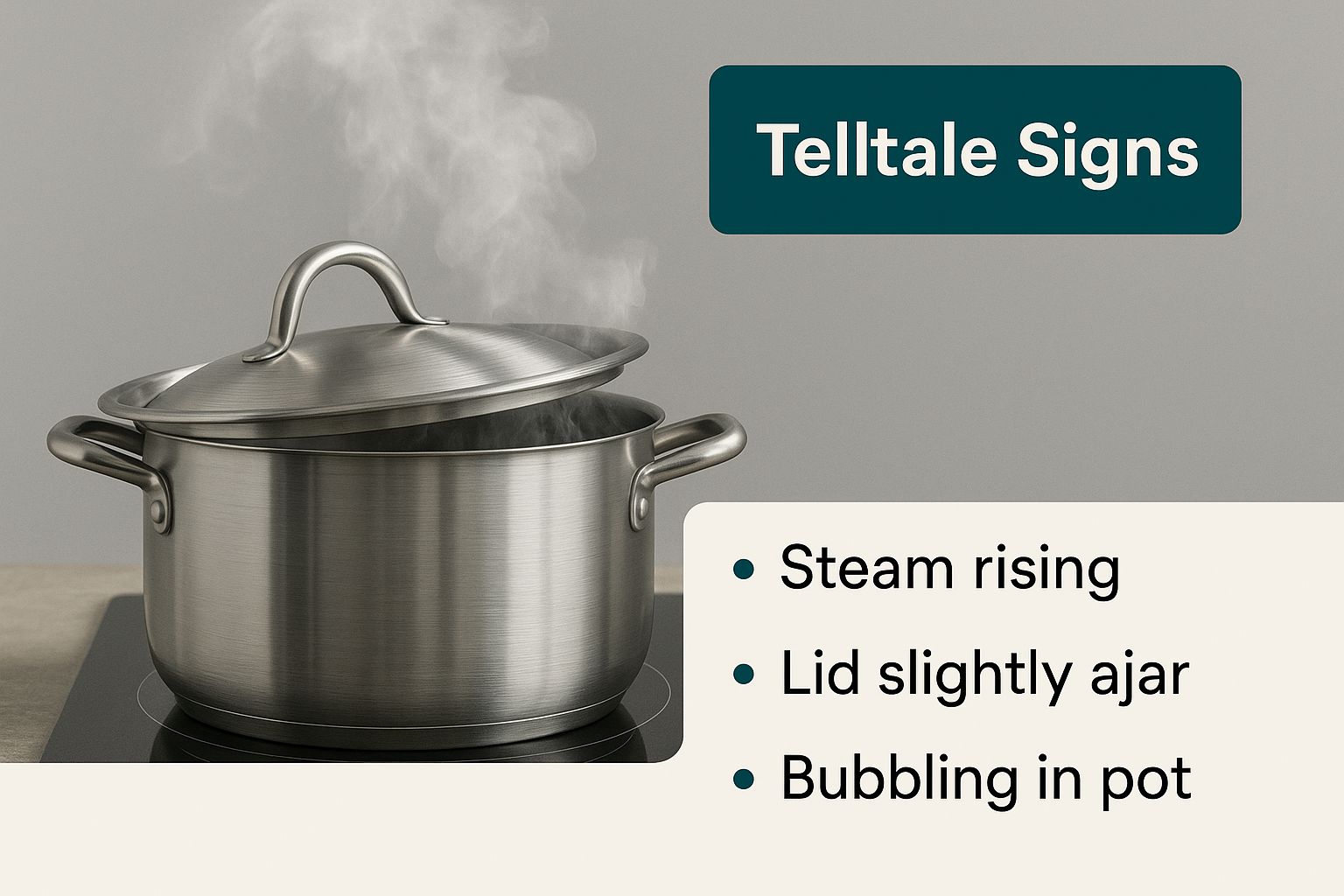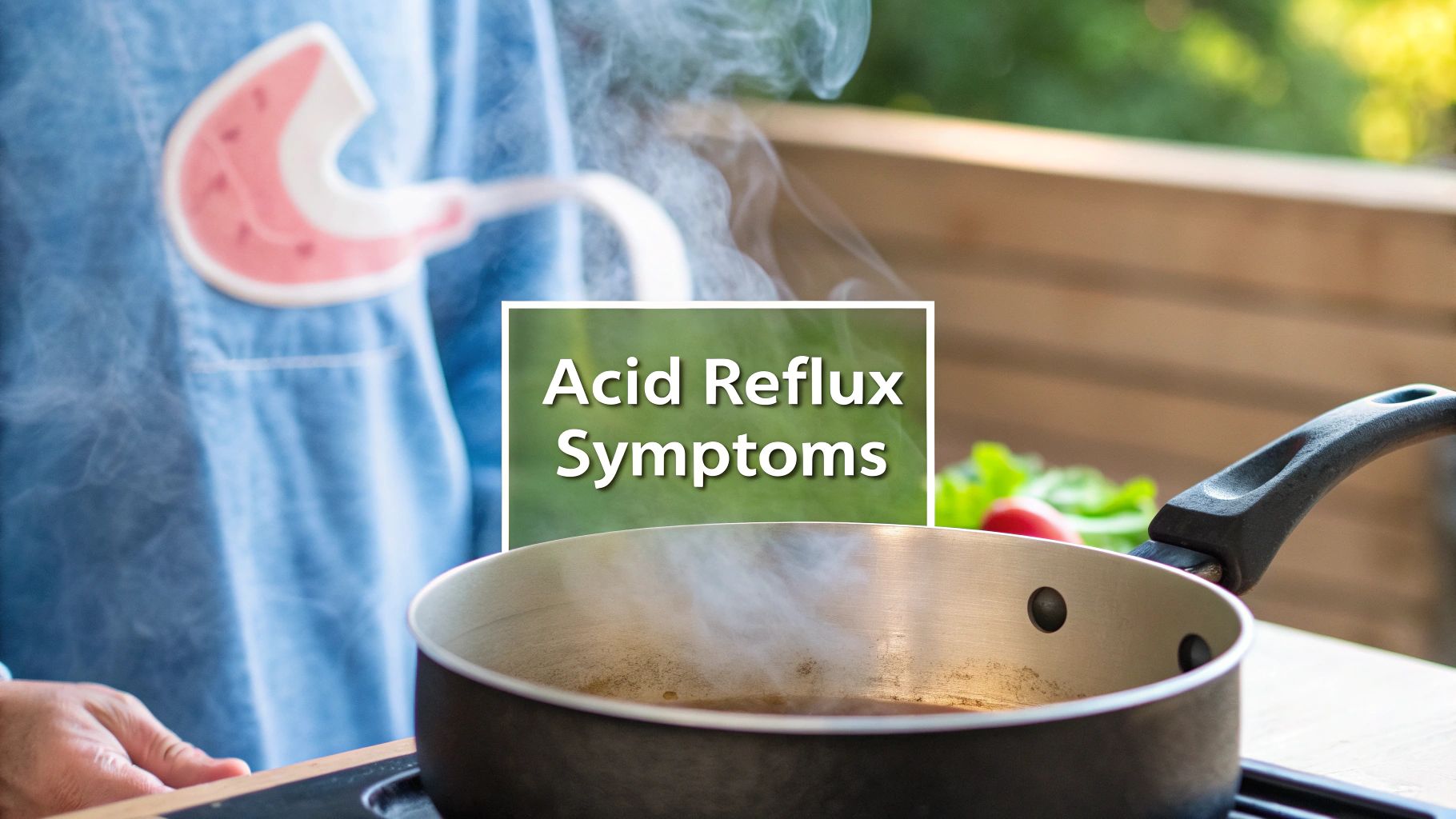.webp)
When you think of acid reflux, what comes to mind? For most people, it's that classic fiery sensation in the chest known as heartburn, maybe a sour taste at the back of the throat, and general chest discomfort. These are the tell-tale signs, often popping up after a big meal or when you lie down, signalling that stomach acid has escaped upwards into your oesophagus.
Think of your stomach as a high-pressure container holding strong digestive acids. The valve connecting it to your oesophagus—the lower oesophageal sphincter (LES)—is supposed to act like a secure lid, keeping everything contained. With acid reflux, that lid doesn't seal properly. It becomes faulty, allowing acid to splash back up where it doesn't belong, causing irritation and that familiar burn.
This simple picture helps explain the classic symptoms. Heartburn is the most famous of the lot, a burning feeling that can travel from your stomach right up into your chest and throat. Then there’s regurgitation, where small amounts of stomach acid or even bits of undigested food make a return journey, leaving a deeply unpleasant, sour taste in your mouth.
This infographic paints a clear picture of these core symptoms, showing how a simple mechanical issue—the LES failing to do its job—is the root cause.

While heartburn and regurgitation are the headliners, they don’t tell the whole story. Many people experience less obvious symptoms that they might not even connect to acid reflux. This can lead to confusion and delayed diagnosis.
Here’s a quick look at how the common and less common symptoms stack up.
Recognising that a chronic cough or hoarse voice could be linked to reflux is a game-changer for many. It broadens the picture and helps people connect the dots when the classic signs aren't there.
These feelings are incredibly widespread. In the UK alone, it's estimated that around 14.5% of the general population suffers from gastro-oesophageal reflux disease (GORD). That’s nearly 9.7 million people regularly dealing with these signs. You can discover more insights about GORD prevalence in the UK on jheor.org.
Often, the discomfort is centred in the upper abdomen, an area where various issues can cause similar pain. If you're experiencing this, you can learn more about the causes of epigastric pain in our detailed guide. Spotting these primary symptoms is the first, most crucial step toward understanding what your body is trying to tell you.
When acid reflux starts to cause trouble, it usually sends a few classic signals. While the list of potential symptoms is long, three tend to show up far more often than others: heartburn, regurgitation, and difficulty swallowing. Learning to spot these is the first step in figuring out what’s really going on inside your body.

The most famous culprit is heartburn. It’s that fiery discomfort that feels like it’s creeping up from your stomach right into the centre of your chest, sometimes even reaching your neck. This sensation is the direct result of harsh stomach acid irritating the delicate lining of your oesophagus. It’s often worse after a big meal or when you lie down, simply because gravity is no longer on your side helping to keep the acid where it belongs.
Beyond that tell-tale burn, a few other key indicators can point towards reflux as the likely cause of your discomfort. Each one offers a different clue about how your digestive system is being affected.
These signals are your body’s way of letting you know that the normal digestive process has gone off track.
It’s important to realise that acid reflux isn't just a simple case of indigestion. It’s a mechanical issue where the valve between your oesophagus and stomach (the lower oesophageal sphincter, or LES) weakens, allowing acid to travel upwards where it shouldn’t be.
If you’re grappling with these or other digestive issues, it’s always a good idea to familiarise yourself with the full range of potential gastrointestinal symptoms. Understanding how they all connect can give you a much clearer picture to discuss with a healthcare professional, helping to build a complete diagnosis.
Not every case of acid reflux comes with that classic, fiery burn in your chest. Sometimes, the most frustrating symptoms have nothing to do with heartburn at all, which is why so many people don't realise what’s causing their discomfort. This sneaky variation is known as laryngopharyngeal reflux (LPR), or more simply, silent reflux.

With silent reflux, tiny droplets of stomach acid travel much higher than the oesophagus. They can reach the delicate tissues in your throat, your voice box (larynx), and even your nasal passages. These areas aren't designed to handle acid, so even a tiny amount causes significant irritation—but often without the familiar chest pain. It means you could be dealing with reflux and never feel it in your chest.
Instead, the signs show up in ways that seem completely unrelated to your stomach. You might find yourself battling issues that feel more like a persistent cold or an allergy you just can't shake.
The signs of silent reflux are often nagging and frustrating because they don’t respond to the usual remedies for coughs or sore throats. It’s worth paying close attention if you're experiencing any of these:
These symptoms pop up because the acid irritates the sensitive nerves and tissues in your throat and larynx. Understanding more about the causes of hoarseness can help you connect the dots between your voice changes and a potential reflux problem.
Silent reflux makes one thing clear: the impact of stomach acid isn't just confined to the oesophagus. Its effects can ripple outwards, causing problems in your respiratory system, mouth, and throat that are easily mistaken for something else.
This constant irritation can also trigger other surprising issues, like chronic bad breath (halitosis) or even dental erosion as the acid slowly wears away your tooth enamel. For some, it can even set off asthma-like symptoms, making breathing more difficult. Spotting these less obvious signs is the first crucial step to getting the right diagnosis and finding relief that actually works.
Most of the time, acid reflux is a manageable, if uncomfortable, part of life. But it's crucial to know when a symptom is more than just a nuisance. Some signs are your body's way of telling you that the reflux might be causing significant damage to your oesophagus or that something else is going on.
Think of them as red flags. They’re the signals that tell you it’s time to stop self-managing and get proper medical advice, fast.
A bit of persistent, mild reflux is one thing, but if your discomfort suddenly ramps up to severe or constant pain, that's a clear sign things have changed. This is particularly true for chest pain, which can be deeply unsettling. While it’s often linked to reflux, it’s vital to understand when it might be something more serious.
If you experience any of the following alongside your usual reflux symptoms, it’s time to contact your GP without delay. These can point to complications like severe inflammation (oesophagitis), scarring, or other serious health issues.
These symptoms are your body's most urgent alert system. Ignoring them can lead to serious long-term health consequences, including a pre-cancerous condition known as Barrett's oesophagus.
This isn't meant to cause panic, but to empower you. Knowing the difference between what's just uncomfortable and what's genuinely concerning helps you take control of your health. It ensures you get the right medical care exactly when you need it most.
If your acid reflux symptoms just won't go away, your GP is the first person to speak to. They’ll usually start by chatting through your medical history and the specific signs you’re experiencing. For many people, this conversation is enough for a diagnosis, especially if you’re describing classic symptoms like heartburn.
But what if your symptoms are a bit unusual, particularly severe, or simply not getting better with initial treatment? In that case, your doctor will likely suggest a closer look to get a clearer picture of what’s happening inside your oesophagus. This helps them confirm what’s going on and rule out anything more serious.
One of the most common procedures to get a direct look is an endoscopy. It involves a specialist guiding a thin, flexible tube with a camera on the end down your throat. This lets them see the lining of your oesophagus and stomach, checking for any signs of inflammation, ulcers, or other changes. You can learn more about similar examinations like a laryngoscopy and pharyngoscopy.
However, the NHS has successfully trialled a much less invasive alternative. The capsule sponge test is a clever device you simply swallow. In a pilot study with over 1,000 patients, it was found that 72% could be safely discharged without needing a full endoscopy after their test results came back clear. You can read the full findings from the NHS pilot on their website.
This shows a significant shift towards gentler, quicker diagnostic methods. The goal is to get accurate answers about the cause of your symptoms of acid reflux with as little discomfort as possible, paving the way for effective, personalised treatment.
Even when you know the main signs of acid reflux, practical questions always come up. You might wonder what specifically triggers your symptoms or how to make sense of what your body is telling you day-to-day. Let’s tackle some of the most common ones.
Absolutely. While stress doesn't directly tell your stomach to churn out more acid, it definitely amplifies the symptoms.
When you’re stressed, your oesophagus can become far more sensitive. This means even a tiny bit of acid feels significantly more painful than it would otherwise. On top of that, stress often leads us into habits that are known reflux triggers—like reaching for fatty comfort foods, drinking extra coffee, or having wine to unwind.
Stress can also slow down digestion, leaving food sitting in your stomach for longer and raising the odds of reflux. It’s clear that managing stress is a huge part of managing your symptoms.
This is a critical distinction, and knowing the difference can be life-saving. Heartburn usually feels like a burning sensation right behind your breastbone. It often gets worse after you eat or when you lie down, and antacids tend to help.
A heart attack, on the other hand, is more often described as a feeling of pressure, tightness, or squeezing in the chest. This pain might spread to your arms, neck, or jaw and is frequently accompanied by other symptoms like shortness of breath, a cold sweat, or nausea.
If you have any doubt at all, especially if the chest pain is new, severe, or just feels different from your usual heartburn, treat it as a medical emergency. Seeking immediate help is always the right choice.
Working out your trigger foods is a very personal journey, as what sets one person off might be fine for another. That said, there are a few usual suspects known for either relaxing the lower oesophageal sphincter (LES) or increasing stomach acid.
The best approach is to keep a simple food diary. By noting what you eat and when your symptoms flare up, you’ll start to see your own personal patterns. A good rule of thumb that helps most people is to eat smaller, more frequent meals and avoid eating for two to three hours before bed.
Having a bit of reflux after a particularly big or spicy meal is one thing, but experiencing symptoms every single day is not normal. If you're dealing with reflux two or more times a week, you may have a chronic condition called Gastro-Oesophageal Reflux Disease (GORD).
Constant exposure to stomach acid can cause long-term damage to the lining of your oesophagus. If your symptoms are that frequent, it’s really important to see your GP for a proper diagnosis and to get an effective treatment plan in place.
At The Vesey, our team of specialists can provide a comprehensive diagnosis and personalised treatment plan to help you manage your symptoms and protect your long-term health. Learn more about our services.

